Gem Library
SPINEL
WHAT IS SPINEL?
Spinel is a variety of gemstone that has been confused with ruby and sapphire for over a thousand years. The name Spinel comes from Latin spina (arrow). It is an oxide mineral and has a hardness of 7.5 to 8 on the Mohs hardness scale ) and is often found in three geological situation
1. As crystals in limestone and dolomites that have been subjected to contact metamorphism.
2. Irregular shaped grains in basic igneous rocks.
3. As water -worn pebbles in alluvial deposits Spinel is very resistant to chemical and physical weathering. Spinel easily weathers out of the marble and is transported by streams. This places spinel in alluvial deposits.
RED SPINEL
Most spinel of "ruby-red colour" are produced from alluvial deposits and ancient gem traders thought these colorful bright red spinel were rubies. Spinels have a significant history and red variety actually believed to be ruby up until 200 years ago. Red spinel is the greatest imposter of gem stones in history. Many famous rubies in crown jewels around the world are actually red spine!. Until the late 19th century, there was no distinction made between ruby and red spine!, as they.look identical and found in the same localities. Many famous old 'rubies" were in fact spinel " ruby" that forms the center piece of the royal crown of England (black princess ruby ) was actually determined to be a spinel. Fine red spinet is actually rarer than ruby.
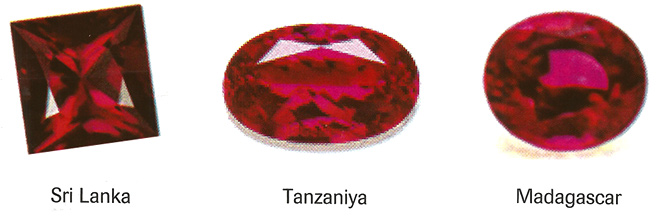
COMPOSITION
Spinal is magnesium aluminum oxide. MgO,Al203 or MgAl204. Spinel is isomorphic stones . It means same crystal system and different composition. Composition varies from MgAl204 to Mg/Zn)Al204, to ZnAl204. Specific gravity is 3.5-3.7, isotropic, with no cleavage , but many exhibit slight parting.
CRYSTAL SYSTEM :- Cubic
CAUSES COLOR:- Spinel is an allochromatic gemstone meaning colours are produced by transition metals.
Red colour in spinet is due to- Cr3+-
Red spinet can have a refractive index up to 1.74. Spinel is isotrophic and the refractive index of common spine! is generally around 1.712 to 1.720. Dispersion is medium (0.020).Luster is vitreous. And fracture is conchoidal to uneven. Transparency is transparent to translucent.
ABSORPTION SPECTRUM:-
Broad absorption band in the green centered at 540m.in red spinet chromium pectrum up to eight emission lines in the red called 'organ Pipe'.
WHAT IS TOPAZ ?
This is aa mineral with a composition of an aluminum fluor-isilicate (Al2SiO4(F,OH)2 + Cr, Mn, V and is next in hardness to corundum and diamonds (two of the hardest natural minerals around).
Until the 1950s, topaz was generally known as a yellow or golden gemstone. Since then, routine radiation and heat treatment of pale -colored topaz to turn it blue.

Colour of Topaz
Cause of Colour
✦ Colourless
✦ Pink, Red – Chromium
✦ Orange - Chromium and colour centers
✦ Blue, yellow, brown - Colour centers
Formation of Topaz
Topaz crystallizes from fluorine -bearing vapor in last stages ofsolidification of igneous rocks. Thus, cavities in lavas andgranitic rocks: in peg matites
Geographic Locations of occurrences
✦ Brazil, Mexico, Sri Lanka, South Africa Afghanistan, Pakistan, India, etc.
The Distribution of Gem Mined Topaz in Sri Lanka
Topaz have been found in primary pegmatite deposits, both as rolled waterworn pebbles and as" in -situ" occurrences in several parts of the country
Topaz pit in Kaikawala Matale The region around polwatta in Rattota — Matale area is particularly interesting for the occurrence of topaz deposits. Research carried out recently has clearly indicated a fluoride rich mineralized belt in this zone and it is very likely that new deposits of topaz and other fluorine rich mineral maybe located in these areas.

GARNETS FROM SRI LANKA
Garnet is most common aluminous mineral found in many rocks. The name garnet is derived from the Latin word granatus which originated when garnet grains in rock were compared to the dark red seeds of the pomegranate fruit. Garnet has wide range of applications due to its specific physical, chemical and optical characteristics.
Garnet is not a single mineral, it has group contains closely related, isomorphous minerals that forms a series. The Garnet members form intermediary minerals between each member having many several minerals, and may even inter-grow within a single crystal.
The major industrial uses of garnet are water-jet cutting, abrasive blasting media, water filtration granules, abrasive powders and as gem stones.
Garnets today are more popular as semi precious gemstone in many parts of the world. Garnets have been used as gemstones for many thousands of years. In ancient times they were known as carbuncles, as were other red gems.
In astrology, the brownish-orange/red hessonite garnet has long been a preferred talisman for warding off the evil influences of the named Rahu. Garnet was considered a sacred stone by many native Indian tribes of North, South and Central America.
Garnet not only as a gem stone, in 1892, the Hunzas used bullets made of garnet against the British troops in Kashmir, believing them to be more deadly than lead. Historically, garnets were believed to give protection from wounds and poison, to stop bleeding and to symbolize truth & fidelity, and bring prosperity.
Garnet: Physical and Chemical Properties
The Garnet Group is composed of several minerals with related chemical formulas.
The generic formula for the common Garnets is:
X2+3Y3+2Si3012
X (Divalent cations) represents Ca, Fe2-, Mn, or Mg
Y (Trivalent cations) represents Al, Cr, or Fe3+
The most commonly encountered minerals in the garnet group include almandine, pyrope, spessartine, andradite, grossular, and uvarovite.
Commonly members in garnet mineral family have a vitreous luster, a transparent-to-translucent diaphaneity, a brittle tenacity, and a lack of cleavage. They can be found as individual crystals, stream-worn pebbles, granular aggregates, and massive occurrences.
Color:
Garnet species are found in many colours including red, orange, yellow, green, purple, brown, blue, black, pink, crimson and colorless. Massive specimens from certain localities can be multicolored white, pink, and/or light green.
Streak: Colorless
Transparency Transparent to opaque
Specific Gravity: 3.5 - 4.3
Luster: Vitreous, adamantine, dull .
Tenacity: Brittle
Striking Features: Crystal forms and hardness
Crystal Structure and Forms of Garnet
Garnets are nesosilicates having isolated SiO4 tetrahearal structure, and it has divalent cations (Ca, Mg, Fe, Mn)2+ and trivalent cations (Al, Fe, Cr)3+ in an octahedral/tetrahedral framework linked with [SiO4]4- tetrahedra. Garnets are most often found in the Rhobododecahedral crystal habit and trapezohedron habit. They crystallize in the cubic (Isomeric) system, having three axes that are all of equal length and perpendicular to each other. Garnets do not show cleavage, so when they fracture under stress, sharp irregular conchoidal fractures present.
Hardness
Since the chemical composition of garnet varies, the atomic bonds in some species are stronger than in others. Thus, this mineral group shows a range of hardness on the Mohs scale of about 6.5 to 7.5. The species like almandine are harder than others.
Occurrence of Garnet
Garnets form in a variety of geologic settings, and the different garnet mineral form depending on the garnet species. Almandine typically occurs in metamorphic rocks like schists and gneisses and granulites, resulting from regional metamorphism of argillaceous sediments. It is a characteristic mineral constituent of the amphibolite metamorphic facies to granulite facies metamorphic conditions. Almandine also occurs in some igneous rocks such as pegmatite dikes and in some granitic and volcanic rocks, as well as in some sedimentary deposits asdetrital grains.
Pyrope is characteristic of ultra – mafic rocke of peridotites, kimberlites, eclogite, and serpentines, and in sedimentary deposits derived from their weathering. Spessartine occurs rare verity in granitic pegmaties, skarns and in sedimentary deposits. Andradite commonly occurs in contact metamorphic deposits, resulting from metamorphism of impure limestone. It also is found in some metasomatic skarn deposits.
Grossular occurs mainly in contact and regional metamorphic deposits, resulting from metamorphism of impure lime stones and cal gneisses. Rarely, it also has been found in alkaline igneous rocks, in pegmatites and hydrothermal veins which are mostly dem- ca-ystal with gem quality. Uvarovite is a rare garnet occurring in peridotite and serpent to associated with chromite.
Garner minerals in Sri Lankan Rocks
Garnet is a common mineral in most of Sri Lankan metamorphic rocks. Sinca Sri Lankan
comprises high grade memtamorphic rocks most stable garnet minerals are associated with many rocks mainly in para-g.neisses with high Alumineouse content.
Major three types of garnet found in Sri Lankan rocks
1) Almandine Garnet (Deep red garnet) Fe2+3Al2Si3O12
2) Pyrope Garnet (Crimson color garnet) Mg3Al2Si3O12
3) Grossular Garnet ( Orange garnet) Ca3Al2Si3O12
Alamondine garnet (Deep red garnet)
Alamondine garnet occurs mostly in rocks belong to granulite grade metamorphic terrain specially para¬gnissic series, such as garnet biotite gneisses, garnet silimanite gneisses (Khondalite), garnet granulite etc. Alamondine garnet found in granulitic grade memtamophic rocks shows different mode of occurrences such as, very coarse grained sub headral grains embedded in the rocks, medium to coarse grained rounded (mostly sub-heardal to an¬headral grains scatter in gneissic rocks and fine grained an-headral garnet in the some gneissic rocks and charnockites. Alamondine garnet bearing rocks are mainly falls in the Highland
Complex terrain of the Sri Lankan major metamorphic rock terrains. Most gem quality alamondine garnet found in Sri Lankan rocks.
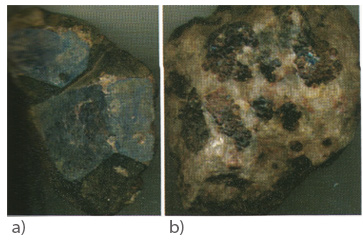 Garnet minerals from Sri Lankan Metamorphic rocks
Garnet minerals from Sri Lankan Metamorphic rocks
a) Mega Crystals of subheadral almandine grains in granulitic rock (a) Sri Lankan rock.
(b) Well crystalline large garnet crystal from
Pyrope Garnet (purple/Crimson Colour Garnet) Pyrope garnet is not a very common mineral found in Sri Lankan rocks. But medium to coarse grained pvrope garnet bearing rocks are found mainly in southwest part of the Highland Complex metamorphic terrain of Sri Lanka
Grossular Garnet (Hessonite garnet) Orange garnet Grossular garnet found in many locations associated with high grade metamorphic rock terrain. Grossular garnet froms in metamorphic crystalline impure marble and calc gnesses. Gem quality grossular garnet found in Buttala Yudaganawa (Gomeda Kanda) is well known. Garnet found in impure marble and calc gneisses are mostly gem quality vary coarse to mega crystals. Many
Maligawila area and whcich are presently mines for hessonite gem. Some minor grossular garnet bearing marble also found in Balangoda- Kaltota area.
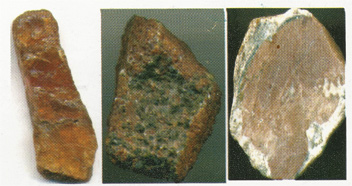 Grossula garnet found in Sri Lankan rocks (Hessonite)
Grossula garnet found in Sri Lankan rocks (Hessonite)
Colour change garnet, Recent discovery of gem quality colour changing garnet in around Telulla, Wellawaya area. These garnets are associated with pegmatites and it show green to red colour change with light.

Some common garnet gems found in Sri Lanka, Garnet plays vital role in Sri Lankan gem industry, especially garnet uses as semi precious stone. But garnet is one of the most of common gem verities found in Sri Lanka. However enormous garnet occurrences are in Sri Lankan rocks and which area mainly primary deposits or in-situ mineralized deposits which are still untouched.
SINHALITE
SINHALITE
Sinhalite was identified as a separate group of gems in 1952. Before that, the brownish color gem minerals found in the gem gravel of Sri Lanka associated with other varieties such as Ruby, sapphire, Garnet and Peridot were treated as a variety of Peridot. But the analysis of chemical composition proved it as a gem mineral of a separate identity.
The chemical composition of Sinhalite is a Borate of Magnesium and Aluminium. Because of its rareness and unusual fascination, it is popular with collectors of rare gems. Although it is a rare crystal, there were instances where specimens of more than 100 carats were found. Sri Lanka was the major source for Sinhalite.
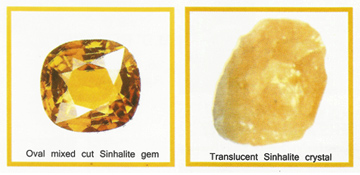 Sinhalite belongs to the crystal group of Orthorhombic and has the strong pleochroism varying from greenish brown and light brown to dark brown. Its hardness according to the Mohr's index is 6.5 . It has R.I. 1.668-1.707 Sinhalite on observing the pleochroism available in the Sinhalite birefringence the Sinhalite (.038)
The famous source for this gem is the Ratnapura district Sri Lanka.
Sinhalite belongs to the crystal group of Orthorhombic and has the strong pleochroism varying from greenish brown and light brown to dark brown. Its hardness according to the Mohr's index is 6.5 . It has R.I. 1.668-1.707 Sinhalite on observing the pleochroism available in the Sinhalite birefringence the Sinhalite (.038)
The famous source for this gem is the Ratnapura district Sri Lanka.
CRYSTALLINITY, THE MAGICAL PROPERTY OF GEMSTONES
Crystals are much appreciated by mineralogists, gemologists and mineral collectors, their beautiful colors and geometric shapes. Crystalline nature of minerals is related to certain unique qualities, which help us to identify.
Minerals are found in rocks as single crystals of mono-crystalline structure and also as aggregates of polycrystalline structure, which consists of small crystal units grown together as single blocks. Solids artificially crystallized by man, are given a special term called synthetics. Any solid material of no crystalline structure, even with a definite chemical composition is non-crystalline
Crystal in perfect sense is a naturally grown mineral with a definite chemical composition. According to the different combination of chemical elements, different crystal structures are formed, usually called mineral species.
Crystals possess characteristic qualities which are not found in other solids such as glasses, plastics, rocks etc. Majority of gems are minerals having crystalline properties, which help us in appreciation for beauty, identification and testing with instruments.
The characteristic qualities of a crystal are
1. Crystal morphology. External geometric shapes showing crystalline features.
2. Directional physical properties
3. Internal growth features
Geometric shapes of crystals help us direct identification and appreciation for collection as a hobby or even to use in a jewellery settings. Identification is based on crystal faces and crystal forms related to one of the seven systems, the angles between faces, general outward shape called crystal habit, and external growth features on crystal faces. Twinning is also a crystalline feature due to the repeated growth of crystal units in definite directions.
1. Crystal Morphology, the study of external faces of crystals
Crystal Forms. Groups of similar geometrically shapes faces with similar properties.
Crystals can be of one form or in a combination of several forms characteristic to different species

Crystal Habit, the general outlook of a crystal.
Crystals are of different habits influenced by characteristic structures, surrounding growth conditions or changes after solidification of crystals. The three gem minerals below show similar general outlook of octahedral habit, but are of different crystal structures
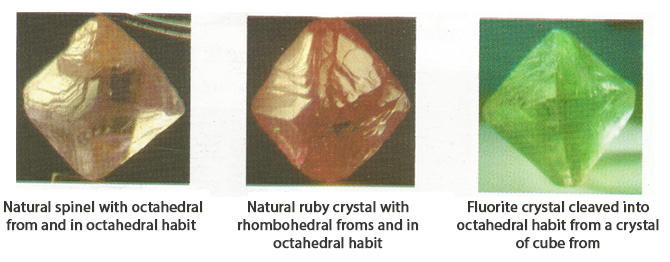
Interfacial angles.
The observation of angles between faces, so-called interfacial angles is a quick method of crystal identification. The measurement of these angles helps for definite testing, Cross section of the crystals show different angles.
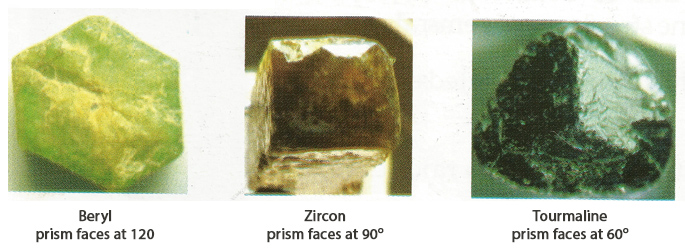 External Growth Features
External Growth Features
Surface growth features include parallel growth lines, called striations, steps, pits and etch marks. These have characteristic shapes in specific directions on different crystal faces.

Twinning
Twins are crystals with two three or several parts of the same mineral grown together in specific directions. Angle between. faces, called the reentrant angle which is directing inwards is the sign of identification Directional Physical
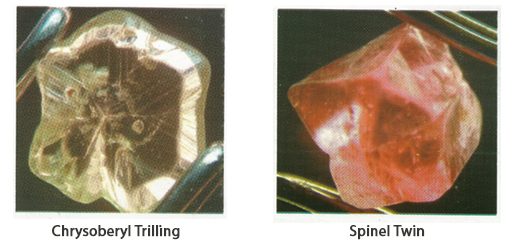
Properties:
Physical properties are directional in crystals, which means that such properties are limited to certain definite directions or theirs values vary in relation to the direction of the crystalline structures. Two groups of directional physical properties are observed in gem minerals. The ranges of values of these properties in crystal materials are much narrower than those in amorphous materials, which make the identification of crystals of different mineral species much easier.
→ Structural properties-
Varying strength of bondage related to direction, which help to separate structurally isotropic materials such as opal from crystalline materials. They are;
→ Hardness which changes in amount with the direction in some gems, as in diamond
→ Cleavage, the ability to split in certain definite directions in some gems such as topaz, diamond, fluorite etc
→ Parting, planes of structural weakness developed after the growth in some crystals such as corundum,
Directions of Hardness, Cleavage and Parting
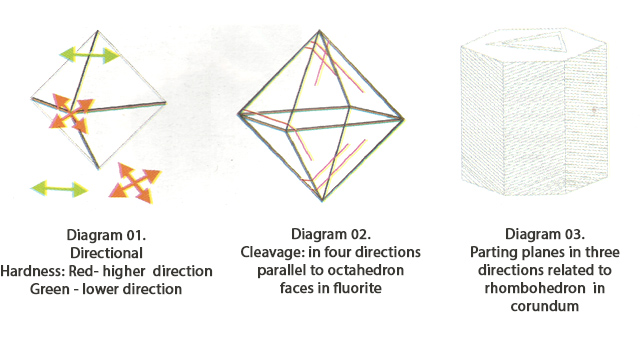
 Optical properties are results due to behaviour of light rays differently with the direction in crystalline structures of gems minerals.
Optical properties are results due to behaviour of light rays differently with the direction in crystalline structures of gems minerals.
→ Refraction Index, the value of which varies in related to directions of most crystals.
→ Polarization causes a ray of light to split into two rays producing double refraction quality
→ Absorption of polarized rays differently produces pleochroism, the appearance of difference in colour with the direction.
→ Interference and diffraction of light rays reflecting from regularly oriented inclusions or structures produce sheen or iridescence displaying some special optical effects such as chatoyancy, asterism or sheen in some gemstones.
3 Oriented internal growth features
→ Oriented Inclusions for identification of gemstones
Inclusions as features for identification of the origin of gemstones: Oriented inclusions such as minerals, silk, negative crystals (oriented cavities), growth planes, twinning planes, colour bands etc, which have been formed in relation to the direction of crystal structures help identification of gems.

 Oriented internal growth features producing Special Optical Effects
Oriented internal growth features producing Special Optical Effects
Some of these produce special optical effects in gemstones, such as star effect in sapphires, ruby, quartz etc, cat's eye effect in chrysoberyl and several others.
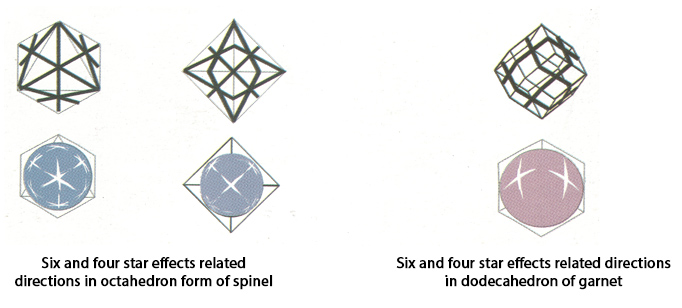

In addition to directional behaviour of physical properties in gemstones due to their electronic bonding of atoms, people believe in unseen, yet unexplainable powers in crystals. They make use of crystals to overcome the illnesses and bad planetary effects by persons who believe in them
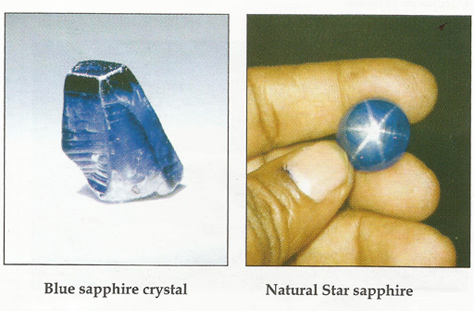
ZIRCON - GEM WITH A 2000 YEAR HISTORY
The mineral Zirconium Silicate due to its gem quality stones were popularly recognized as Zircon. Sri Lankans were producing jewellery studded with Zircon stones for more than 2000 years. The Arabian traders were the earliest buyers who gave the name “Zircon” derived from the Arabic word “Zargun” meaning golden colour. Arab Traders have bought these stone from Sri Lanka and sold to Indian craftsmen for making jewellery. European jewellery makers commenced using Zircon only in 1920s.
Zircon comes in orange or colourless, brownish green, dark red, or orangish- brown. The colour changes are due to the changes of elements in the mineral as impurities. The colorless display a strong adamantine luster and sells as American diamonds.
Cubic Zirconia. is a man made stone containing Zirconium Dioxide and the natural zircons are Zirconium Silicates. Cubic Zirconia is a stimulant for diamond and it has no natural counterpart.
Emerald belongs to the hexagonal system of crystallization, as it comes under the species of Beryl, and is one of the lighter variety of transparent gem materials, it’s specific gravity is from 2.67 – 2.75, It is nearly double the size of a sapphire of equal weight.
Chemical composition is Be3AL2Si3O18 with Chromium (Cr+3) and the hardness of emerald is 7.5 – 8. It is transparent and its luster is vitreous. It possesses double refraction, though in very small degree, and acquires positive electricity by friction. There is another variety of Beryl also in green colour due to vanadium. It is not called emerald, it is known as Green vanadium Beryl. Some of very fine green beryls due to vanadium have been discovered.
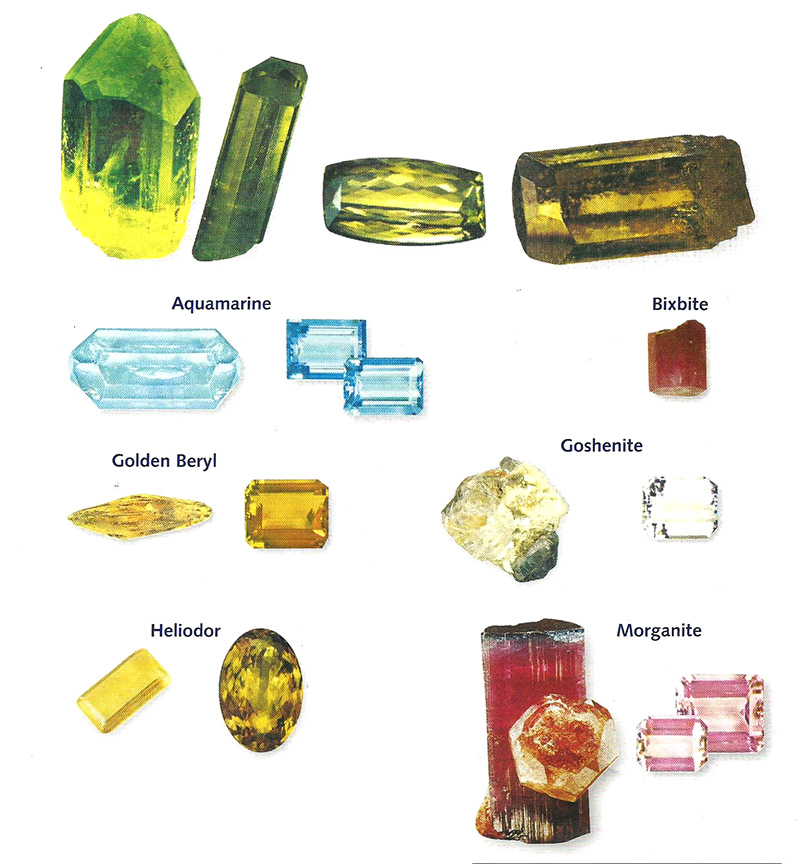
CHATOYANCY IN CATS- EYE
Beauty is almost always associated with color and clarity (lean and transparent) i.e free from inclusions and defects. This is true for many valuable gemstones such as Diamond, Ruby, Sapphire and emeralds etc. But some gems owe their beauty to lack of transparency and abundant inclusions and defects.


Chatoyancy of Cat’s Eye effect
Some gemstones with acicular of needle like mineral inclusions or tubes oriented in one particular direction of the crystal structures create a silky reflection effect. When such stones are cut with a curved surface (‘en cabochon) they display chatoyancy of the Cat’s eye effect.

What is seen is a silvery streak of light, which is displayed across the curved surface. This has the striking resemblance to the pupil of a cat’s eye. You may have noticed that the pupil of a cat’s eye is round; however it becomes a sharp vertical line when the cat is directly exposed to the sunlight or under any form of artificial light.
But the gemstone Cat’s eye is seen well only under the sun of incandescent light, which is focused, but under florescence light the ray is diffused of dissipated.
This Silvery streak of light could be very sharp or diffused. And the effect could be either enhanced of diminished by the gem cutter by the variation of the curved surface.
The value of cat’s eye will depend on the effectiveness of the ray, the size of the stone and its colors. Some Common Colors in which cat’s eye occur are gray, greenish brown, apple green, greenish yellow, brown and honey color. Honey color stones are very much in demand.
Chatoyancy is also seen in many other gems such as Tourmaline, Zircon, Enstatite , Apatite , Fabrolite , Quartz, etc.
ASTERISM OR STAR EFFECT
An asterism is an optical phenomenon displayed by some gemstones in the shape of ‘star’ on the surface of a cabochon cut from the stone. As a single ray is displayed in some as cat’ s eye effect due to a single set of parallel inclusions, when there are more than one set of parallel inclusions in the gemstone it may show a four, six or twelve rays star depending on the mineral. These set of inclusion are set parallel of the crystallographic axes of the crystal. Like in the cat’s eye, the base of the cut stone should be made parallel to the layer of inclusions.
Stars of corundum group of gems are known as star sapphires(Blue, Yellow, violet) of star ruby if the stone is red and have six rays. Star sapphires and rubies get their asterism from the titanium dioxide impurities (rutile) present in them. Rarely sapphires have another 3 set of inclusions made of iron oxide causing six more weak rays, thus resulting in 12 ray stars.

Some gems such as garnet and diopside produce 4 ray stars, because they have only two sets of inclusions. Due to these inclusions, star stones are never transparent but either translucent or opaque.
A distinction can be made between two type of asterism: Epiasterism , such as that seen in sapphire gemstone. To see this effect, the stone must be illuminated from behind.

SPANGLES
The presence of flakey inclusions in gemstones or glass creates reflections which are extremely attractive. In most cases inclusions are parallel to the base. Oligoclase feldspar contains mica flakes usually parallel and when the stone is cut en-cabochon with flakes parallel to the base, it produces attractive spangles, and the stone is then called ‘sun stone’. It has been imitated by using copper flakes in artificial glass and it is called ‘gold stone’. Heated amber when immersed in water causes cracks which are disorderly arranged and cause beautiful reflections and the effect is called ‘sun spangle.
CORUNDUM
The mineral called corundum forms as precipitous bipyramidal, barell shaped prismatic, flat tabular or rhombohedral crystals. It also occurs in massive and granular habits. Corundum is the mineral name which is used under the mineral groups. Most people are familiar with corundum, however very few know it by its mineral name.

Corundum is also a rock forming material. It for ms in silica-poor igneous rocks and metamorphic rocks, rich in aluminum. It is an insoluble material.
Most corundum are found in alluvial deposits as secondary gem deposits, are sources of rubies in several parts of the world. Ex. Sri Lanka, Myanmar, Cambodia, India, Afghanistan, Thailand etc. Corundum are found as a primary mineral in igneous rocks rocks such as syenite,
Nephline in locations where aluminous shale’s or bauxites have been exposed to contact metamorphism. Recent discovered corundum mineral deposit found in Sri Lanka in Kataragama area as blue Sapphire crystals.
Corundum is very hard mineral with a hardness of 9 on the mohs hardness scale. It is the 3rd hardest mineral known, with diamond and Moissanite being minerals with a greater hardness.
Physical properties of corundum are follows :
Luster - Adamantine, Vitreous, Pearly
Diaphaneity - Transparent, Translucent, Opaque
Colors - As Ruby, Padparascha & Sapphire
Streak - White
Hardness -(Mohs)-9
Tenacity -Brittle
Cleavage -Non observed
Parting -Rhombohedral and Basel parting
Fracture -Irregular / Uneven, Conchoidal
Density -3.98-4.1 (Measured) 3.997g /cm3 (calculated)
Important optical property of corundum is refractive index- 1.762 to 1.770 and maximum Birefringence of 0.009Asterism is a optical effect in corundum. It shows s 06 rays or sometimes 12 rays which is rare. Those are called Star Sapphire.
RUBY
A gem quality specimen of corundum with deep red color is known as 'Ruby
Ruby forms as bipyramidal, prismatic, flat tabular or Rhombohedral Crystals. It is red in color due to the presence of chromium. To appear as deep red ruby color chromium percentage should be 0.10 colors of Ruby very as pigeon Blood Red , Golden Red , Bright Red, These Color of Ruby are used as trade name

PADPARASCHA
A gem quality corundum with Pinkish-Orange is called 'Padaparascaha'.
This Corundum variety mostly forms as bipyramidal and prismatic crystals. It is pinkish orange in color due to the presence of chromium and iron as impurities.

SAPPHIRE
A gem quality corundum with any color or colorless is called Sapphire. Ex. Blue, Pink, Yellow, Violet, Purple, Green, Brown, etc.. and also Bi-Color Sapphire.
Different colors of corundums excluding ruby & Padparascha arecalled sapphires. Colors very as mentioned above.Impurities are Titanium, Iron, and Chromium.

GEUDA
Gemstone in rough from with the appearance of silky, Milky, Smoky etc.. is called Geuda. This Variety could be converted into Blue, Yellow etc..by heat treatment.
This is a special variety of corundum which shows dull appearance until convert into colorful gemstone by heat treatment. It looks like smoky, milky, silky snd some sre with diesel color inside the stones. Due to the presence of Rutile (Ti O2) as impurities, it appears as described above.

SRI LANKAN GEMS IN PICTURES
Sapphires for Royalty
|
 Gem Mine - Sri Lanka
|
 River Bed Mining
|
 Mechanized Mining
|
 Collecting Gem Earth
|
 Washing Gem Earth
|
 Picking the Gems |
 Rough Sapphires
|
 Traditional Gem Cutting Machine
|
|
 Fine Yellow Sapphire |
TREATMENTS TO RUBY & SAPPHIRE
If you have eaten meat, fruit and milk products bought from a supermarket, you have consumed food which has been irradiated, dyed, heat treated (Pasteurized), coated with wax, injected with hormones and sprayed with dangerous chemicals. The food industry uses these treatment methods because most people prefer to buy appetizing, shiny, good size, bacteria-free food products.
Untreated food however, is available and some people are willing to pay higher prices for it. The organic produc

